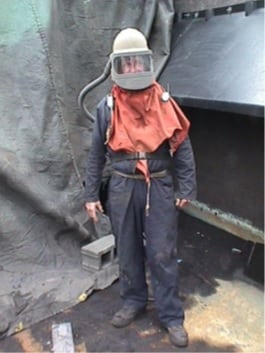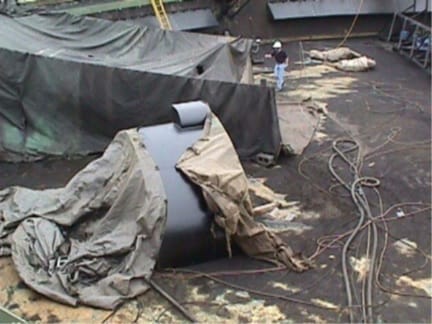Engineering Controls Database
Control Technology and Exposure Assessment for Occupational Exposure to Beryllium: Abrasive Blasting with Coal-slag
|
Occupational exposure to beryllium occurs at places where the chemical is mined, processed, or converted into metal, alloys, and other chemicals. Health risks exist if beryllium-containing materials are dispersed as a dust, fume, mist, or beryllium-containing solution or suspension that can be inhaled or come into contact with unprotected skin. Workers engaged in machining metals containing beryllium, recycling beryllium from scrap alloys, or using beryllium products may also be exposed to higher levels of beryllium. The number of workers exposed to beryllium or beryllium compounds has been estimated to be 21,000. |
|
|
Chronic beryllium disease occurs when a sensitized worker’s lungs react with beryllium that has been inhaled, producing lung granulomas and scarring. Chronic beryllium disease usually has a slow onset of symptoms. It can be so mild at the time of diagnosis that the affected worker has no suspicion that he or she has a lung disease. However, when chronic beryllium disease pro-gresses, the widespread granulomas and associated lung damage cause chronic chest symptoms such as coughing and shortness of breath on exertion. Other symptoms that may develop in some persons with chronic beryllium disease are unusual fatigue, night sweats, and weight loss. The symptoms and lung function abnormalities often respond to corticosteroid medication such as prednisone or other medications that suppress the immune system response to beryllium. However, these medications do not cure the disease; they have side effects and must usually be taken indefinitely to prevent progressive lung damage or slow the rate of clinical deterioration. Some people with chronic beryllium disease eventually require supplemental oxygen, become severely disabled, and even die because of respiratory failure or insufficiency. Acute beryllium disease has been diagnosed in the past, but it is rare today. The disease typically has a quick onset with symptoms resembling those of pneumonia or bronchitis. It occurs after exposure to soluble beryllium salts, which are used in the making of beryllium metal. Acute beryllium disease usually resolves within months of stopping beryllium work, but some affected workers later develop chronic beryllium disease. Significantly elevated risks of lung cancer have been reported for workers exposed to beryllium; the National Toxicology Program lists it as a known carcinogen and the International Agency for Research on Cancer reaffirmed its classification as carcinogenic to humans. Controlling beryllium exposures to prevent chronic beryllium disease should also reduce the risk for lung cancer. |
|
|
The National Institute for Occupational Safety and Health (NIOSH), working under an interagency agreement with the Office of Regulatory Analysis of the Occupational Safety and Health Administration (OSHA), conducted a study to survey occupational exposures to beryllium to document engineering controls and work practices affecting those exposures. This write-up provides an overview of a control technology and exposure assessment on beryllium exposure during abrasive blasting with coal-slag conducted by the Engineering and Physical Hazards Branch (EPHB), Division of Applied Research and Technology, NIOSH (Crouch et al 2003). Additional information on preventing sensitization and disease from beryllium exposure can be found in a recent NIOSH Alert (NIOSH 2011). On June 21-23, 2004, research personnel from NIOSH conducted a site visit at the Annapolis Water Reclamation Facility in Annapolis, MD. The purpose of the study was to identify and describe the control technology and work practices in use during abrasive blasting operations in Secondary Clarifier No. 2, and measure beryllium exposures associated with the use of Black Beauty™ coal slag abrasive. Published reports indicate that coal slag abrasives, such as Black Beauty™, contain beryllium. Process Description and Work Practices Abrasive blasting was conducted inside Secondary Clarifier no. 2, an empty open-top, in-ground circular vessel 110 feet in diameter and approximately 10 feet deep. The abrasive media, Black Beauty™ brand coal slag abrasive, was supplied in 100 pound bags. A helper loaded bags by hand into a blast pot with a capacity of 500 pounds. Compressed air was supplied by an Ingersoll Rand model P375 WJD compressor. The nozzle holder was a Clemco 0578 holder. The nozzle was a number 5 nozzle stamped 10TC5BP. The new steel on the side of the tank was being cleaned of mill scale down to white metal in preparation for painting, part of a tank renovation project. Personal Protective Equipment The blaster wore steel-toed shoes, cloth coveralls, leather blasting gloves and a Bullard type CE air-supplied respirator (88 series, Bullard, Cynthiana, Kentucky). See Figure 1. Air was supplied to the respirator from a compressor (Ingersoll Rand, Model P375WJD). The supply hose carrying air to the respirator from the compressor contained a CO alarm (Enmet Corp., Ann Arbor, MI, Model ISA 34 RAL). The blaster’s helper wore steel-toed shoes, painter’s pants, a T-shirt and a head cloth.  Control Technology A temporary canvas enclosure had been erected surrounding areas of the tank being blasted, primarily to keep settled particles confined for easier cleanup. See Figure 2. An exhaust blower (Abatement Technologies, Model # H 2000 HP) was attached to the enclosure. The exhaust flow rate was nominally 2000 cfm. The exhaust was directed through a filter before release to the ambient environment. The main purpose of the blower was to clear the air of dust so the blaster could see well enough to perform his job. Although the air exiting the filter contained no visible dust, frequently large plumes of visible dust were released from gaps in the canvas enclosure during the blasting operations, at times, continuously.  CONCLUSIONS AND RECOMMENDATIONS Although the percentage of beryllium in the fresh abrasive was found to be relatively low, the blaster exceeded the NIOSH REL and OSHA PEL for beryllium in construction on the first day. He exceeded the OSHA PEL for total dust on both days. The respiratory protection worn by the blaster appeared to provide adequate protection from this potential exposure, based upon the assigned protection factor for that type of respirator. The following guidelines are provided in the NIOSH control technology assessment EPHB- 263-13a (Crouch et al 2007). Additional guidelines for workplaces where beryllium may be present are available from NIOSH (NIOSH 2011). Employers should ensure that employees use the following safe practices to reduce their exposure to beryllium: • use high-efficiency particulate air (HEPA) vacuums to clean equipment and the floor around their work areas; • do not leave a film of dust on the floor after the water dries if a wet mop is used to clean; • do not use long vacuum hoses and do not loop the hoses that are used; • never use compressed air to clean parts or working surfaces; • avoid prolonged skin contact with beryllium particulate; and • do not allow workers to eat, drink, smoke, or apply cosmetics at their work stations. Also, when abrasive blasting is performed outdoors, in addition to worker protection considerations, U.S. Environmental Administration (EPA) regulations must be observed. Some guidance for EPA compliance can be found in the documents AP 42, Fifth Edition, Volume I Chapter 13: Miscellaneous Sources, 13.2.6 Abrasive Blasting (EPA 2007) and Emission Factor Documentation for AP-42 Section 13.2.6 (EPA 1997). |
|
| 263-12-A; 263-13-A; | |
|
Crouch KG, Echt AS, Kurimo R, Gagnon YT [2007]. Control technology and exposure assessment for occupational exposure to beryllium: abrasive blasting with coal-slag. Cincinnati, OH: U.S. Department of Health and Human Services, Public Health Service, Centers for Disease Control and Prevention, National Institute for Occupational Safety and Health, DHHS (NIOSH), EPHB 263-13a. EPA [1997]. Emission Factor Documentation for AP-42, Section 13.2.6, Abrasive Blasting, Final Report. Research Triangle Park, NC: U. S. Environmental Protection Agency, Office of Air Quality Planning and Standards, Emission Factor and Inventory Group. Available at http://www.epa.gov/ttn/chief/ap42/ch13/bgdocs/b13s02-6.pdf. Accessed April 2011. EPA [2007]. AP 42, Fifth Edition, Volume I, Chapter 13: Miscellaneous Sources, 13.2.6 Abrasive Blasting. Available at http://www.epa.gov/ttn/chief/ap42/ch13/final/c13s02-6.pdf. Accessed April 2011. NIOSH [2011]. Alert: Preventing sensitization and disease from beryllium exposure. Cincinnati, OH: U.S. Department of Health and Human Services, Public Health Service, Centers for Disease Control and Prevention, National Institute for Occupational Safety and Health. DHHS (NIOSH) Publication Number 2011–107. |
|
|
abrasive blaster abrasive blasting beryllium mining blaster helper manufacturing |
